Quantum’s Scott Nixon was fortunate enough to sail with Peter Bergendahl and his Melges 24 team Wardance for the 2018 New York Yacht Club One Design Regatta. The winds were light on Narragansett Bay, but a thoughtful approach to every element of the race ensured that Wardance took the top podium spot with three bullets and a second place. Here’s a technical look at how they did it.
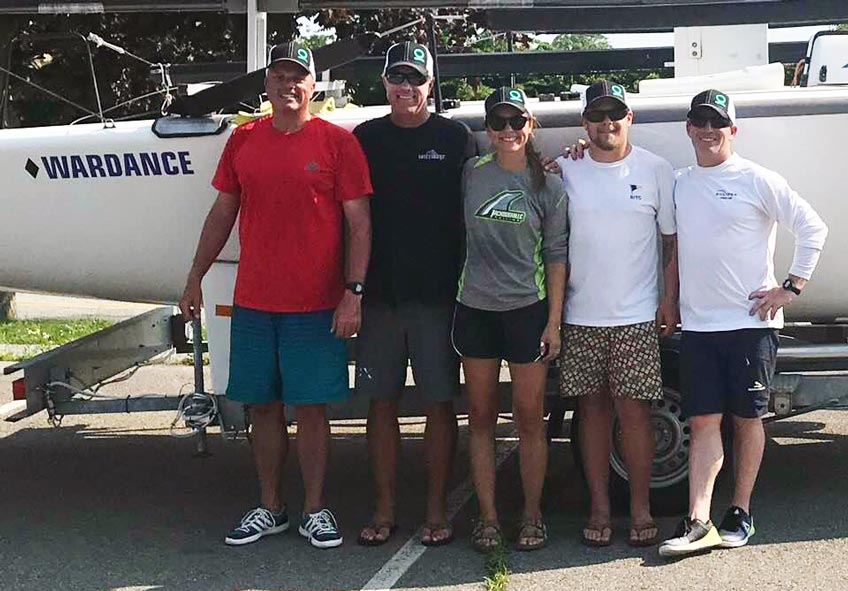 Peter Bergendahl's Melges 24 team poses after securing the class win at the New York Yacht Club One Design Regatta.
Peter Bergendahl's Melges 24 team poses after securing the class win at the New York Yacht Club One Design Regatta.
We had a great weekend of light-air sailing on Narragansett Bay with the North East Melges 24 Fleet–a fun regatta on and off the water and lots learned from the two days of light-air racing. I was fortunate enough to sail with Peter Bergendahl and his Wardance Melges 24 team in a competitive event where the Connecticut Melges 24 fleet showed their light-air sailing expertise. Here is a detailed inside look at how we approached this light-air race to win with three bullets and a second place, including our thought process, execution, and lessons learned. I hope the detailed tuning information and our strategy for light air can help you elevate your next race.
Set up
We sailed with the 2018 Quantum AP jib, a Quantum AP main and an A2 Runner spinnaker. The rig was set at the Quantum base tune. 15 on the uppers with the PT1 gauge. We backed off the lowers 1.5 full turns to give the mast almost one inch of sag at the spreaders (with no backstay on). We sailed with the jib lead in the third hole forward of the third screw head (base setting).
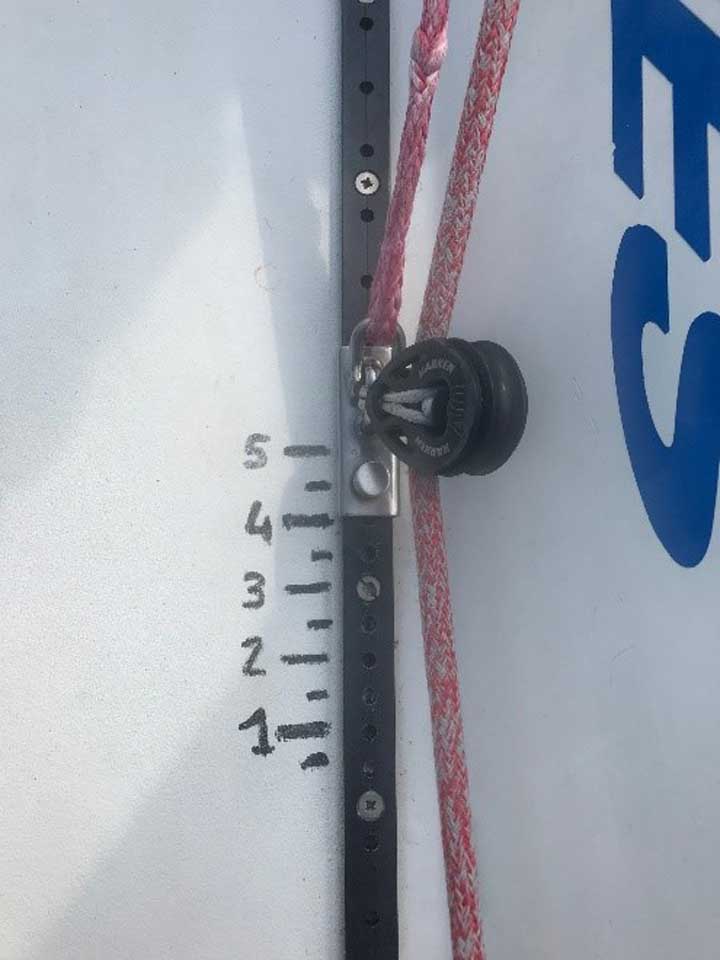 Position in 6 TWS.
Position in 6 TWS.
This gave the jib plenty of return and power down low for the choppy conditions off R2 in the bay. To match the mainsail leech to the jib, we sailed with the traveler all the way to windward 100 percent of the time. We played the mainsheet so that it was not too tight and to keep the top leech telltale at the #1 batten flying about 75 percent of the time. We actively played the jib sheet but always kept the jib leech telltale flying 100 percent of the time. As the breeze got light and we dropped below five knots of boat speed, we would ease the sheet one to three inches to help with power. Every time we eased the sheet, the driver commented that it felt better! Make sure the jib is not too tight in the light and shifty stuff. It was beneficial to ease off the line a lot coming out of our tacks and also when we hit multiple bad waves. We added more backstay as we added more crew weight to the rail. With one person hiking, we had about 20 percent backstay on. When two hiked, we would increase it to 40 percent, and, in the rare times when we were all on the rail in 10 knots, we would have 60 percent on. The loose rig helped to tighten the head stay, enabling the head of the jib to open up and the leeches to twist slightly so that the boat could sail faster around 5.3 knots upwind.
Starting
In under 10 knots, the priority was clean air. We did lots of nice, slow pings on both ends of the line so that we could trust the Velocitec ProStart in the final minutes of the approach. We also did a practice start before the races, so we had a good feel for the rate of acceleration needed for the given wind speed and current. After the practice starts, we discussed how we would adapt what we learned to get off the line fast and clean. Most of the time we had to adjust by setting up earlier (closer in meters to the line) and building full speed at 30 seconds to hit the line at full target speed of five knots. In light air, aggressive starters are rewarded quickly since they have good speed and can sail in clear air. Most of our starts were port approaches, so we could start below the fleet, put our bow down, and sail fast right away. In light air, we kept the jib out during the entire prestart so we could be faster than the approaching boats around us. We never got below 15 meters, which gave us freedom to lee bow starboard boats tightly so that we were free to go fast as soon as possible.
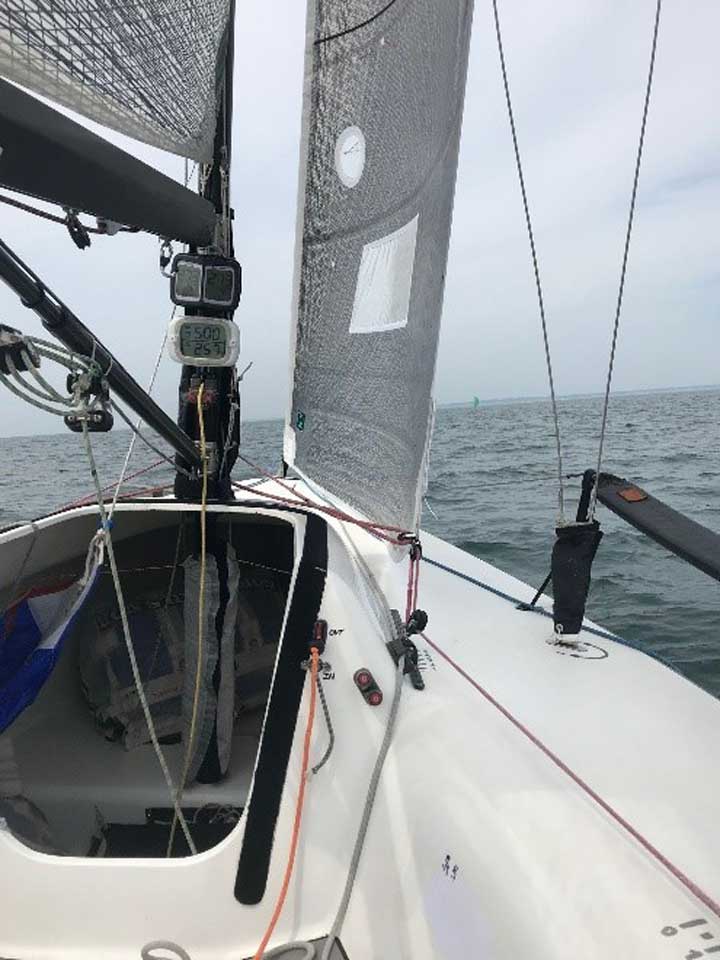 20% backstay with good sag.
20% backstay with good sag.
Upwind
Our plans were based on what we visually saw up the first beat before the start. The goal was to sail the side that looked to have more wind. The Etchells started first so we had a great view of the first shift and the final shift into the first windward mark. In the SSW breeze, the top left was mostly favored, especially in the tail end of the flood tide. Sailing in clear lanes and getting to the left was paramount. Once this was executed, we could tack and protect the boats under us going up the beat on port tack. The Melges 24s do not like to sail in packs so our priority was to sail by ourselves in big lanes so our boat speed could pay off and keep us in the front pack. Eliminating unwanted tacks is also key in light air as a tack cost about three to four lengths in less than 10 knots of wind. At times when we were ahead, we would get to the favored lay line making it hard for boats behind us to pass.
Downwind
The wind was very patchy, so we focused on a good spinnaker set and then furled the jib immediately in order to get sail target speeds as soon as possible. Many teams sailed too high, which feels good but is actually a VMG loss on the run. Again, the key is clear air. Sailing away from the packs enabled us to sail our own course without wasting extra distance sailing high (protecting your air from windward boats). Especially when we were ahead, we eliminated unneeded gybes, which helped keep us out of the charging packs behind us.
While sailing downwind, we added jib sheet tension when furled to keep the rig stable and not bouncing in the chop. Our backstay was all the way off in the eight-to-10 knot winds, but we added some backstay in the five knot lulls to keep the rig firm and help the main and spin leeches twist off. This enabled the boat to sail faster in the higher angles due to the very light winds.
Leeward gates
Halfway down the run we started thinking about the favored gate and what side of the next beat we wanted to sail to. Once we selected the gate, our priority became a clean entry at full speed to enable us to execute a smooth/fast rounding. Also key was choosing a gate that kept us clear of the downwind boats and in clear air for the first part of the upwind leg. The biggest gains in the race (besides the start) were the gate roundings. Teams that didn’t round clean had trouble clearing and getting the boat to targets. If you rounded behind, a quick tack to get into clear air prevented you from losing too much ground on the leaders in clear air.
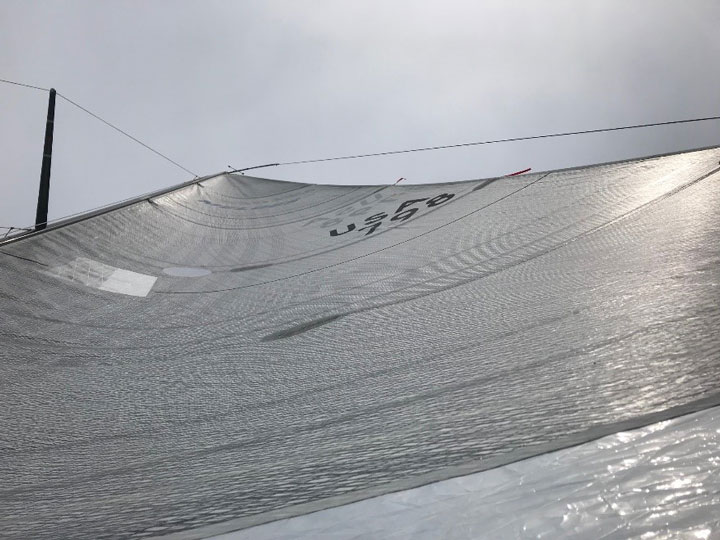 6 TWS with good twist. Loose outhaul, no cunningham, max traveler and sheet just firm so top tell tale stalls only 25% of the time. Play backstay in puffs.
6 TWS with good twist. Loose outhaul, no cunningham, max traveler and sheet just firm so top tell tale stalls only 25% of the time. Play backstay in puffs.
Newport conditions
Light backdoor sea breezes are tricky since there is no real building of the wind during the day. The hot, hazy conditions and lack of puffy cloud buildup over the Newport beaches were the cause of the lighter winds both days. We sailed mostly in an increasing ebb tide, which didn’t help pull cooler winds in from the ocean. In winds left of 230 degrees, the left side normally is a bit favored early in the day. This held true on most first beats, but, as the ebb increased on both Saturday and Sunday, the right side of the course came more into play. On many of the second beats, boats that spent more time on port getting right of the fleet did well. The ebb was pushing boats up the beat right to left on port tack. Also, many gains were made leading the packs downwind with an earlier gybe than normal. Coming out of Newport, this helped get the boat up-current in the ebb and better VMG on port gybe.
Lesson Learned
- Keep the rig loose and play the backstay in the puffs.
- Keep the jib eased until all are hiking and/or on the rail. Put the jib lead more forward than you think necessary for max power down low on the sail and good return on the mid leech.
- Sail with the main traveler all the way to weather and sheet main so top telltale is flying 75 percent.
- Leave the vang off upwind, but pull some on downwind so pumps are effective. This also gives leech tension off the wind.
- When sailing with five people, we were faster with two forward crew down below and forward upwind. It was hot down below, but the crew had easy access to the lunch boxes! Downwind, we sailed with one person down below to keep the center of gravity low and the weight forward of the mast.
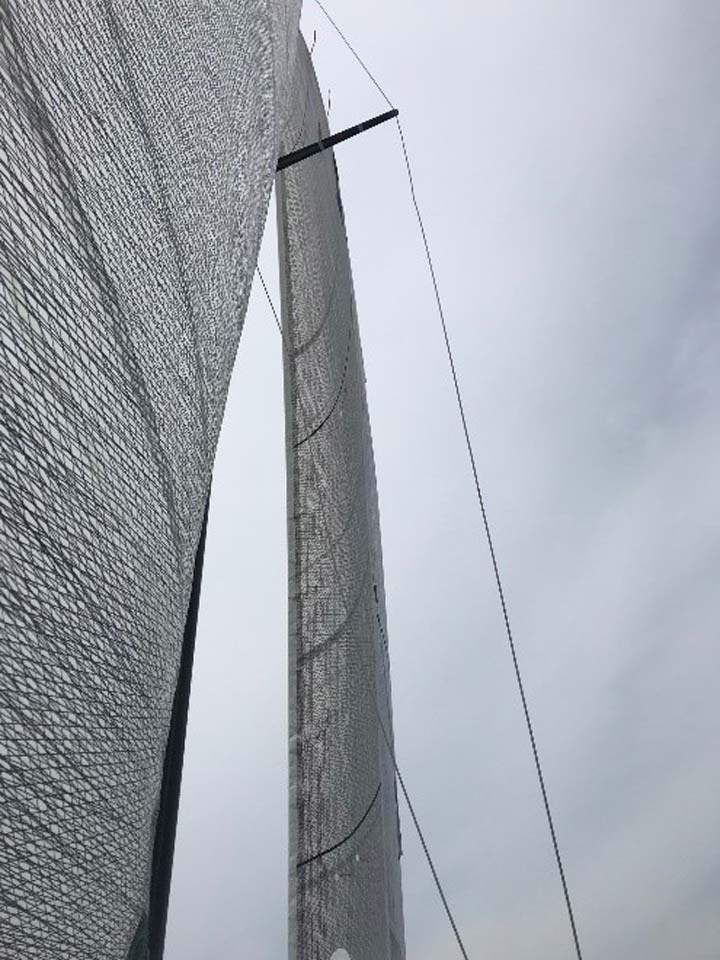 Telltales flying 100%
Telltales flying 100%
- Trimmer-Driver communication is key. Spinnaker trimmer drives the boat downwind. Good communication from the trimmer on pressure or lack of pressure enabled the helmsman to sail proper angles and keep the boat moving. ….but don’t point too high as you only went slightly faster but lost VMG to the gates.
- Keep the spinnaker curling at all times. This takes full concentration, but the spinnaker never gets choked or over-trimmed and keeps you fast.
- Make slow gybes and smooth turns and pull the new sheet on before the boat event turns so that the spinnaker fills before the mainsail comes across to the new side. This will keep you fast!
- Do your prestart homework every race. Get accurate pings. Practice starts. Keep the jib out in less than 12 knots to get full boat control. Smooth your arcing turns in prestart so you don’t kill speed.
- Get up-current both downwind and upwind when the breeze gets really light (under six knot) so you don’t lose too much VMG on the next mark.
- Drink plenty of fluids in the hot, light stuff so you can stay calm and cool all day.
- Don’t order the extra floater shots in your Mudslide at the Bannister’s Wharf outside bar as they are not needed!
- Don’t miss the regatta party and a cocktail on the hill at the NYYC at sunset. It’s well worth it and a great tradition!
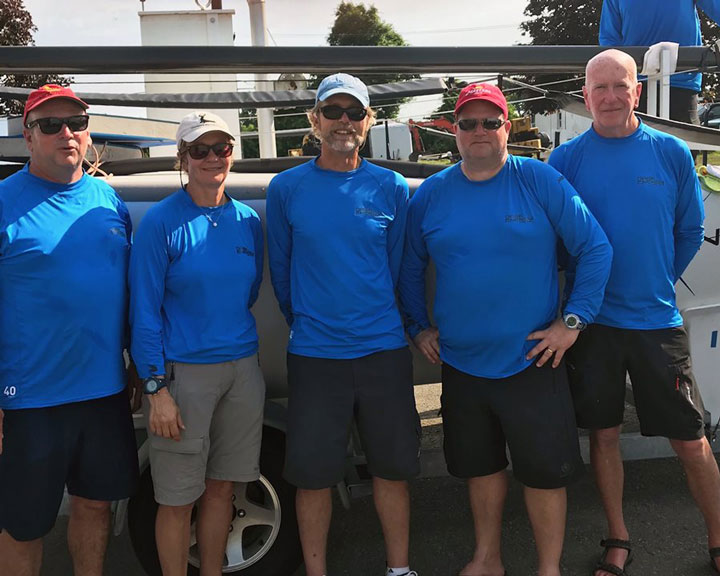 Laura Grondin with her 2nd place Melges 24 team.
Laura Grondin with her 2nd place Melges 24 team.
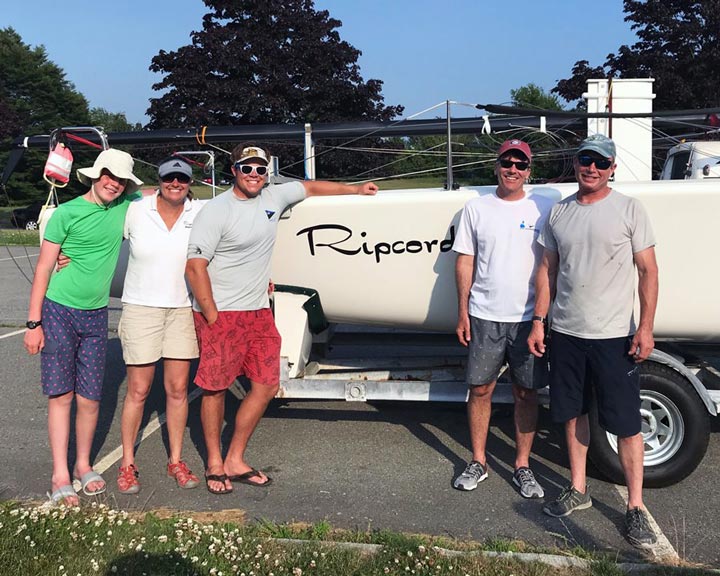 Paul Bergendahl and his 3rd place Melges 24 team.
Paul Bergendahl and his 3rd place Melges 24 team.
I also want to give a big shout out to Laura Grondin's Dark Energy, Paul Bergendahl's Ripcord, and KC Shannon's Shaka who stood next to us in places 2nd, 3rd, and 4th. View the full results.